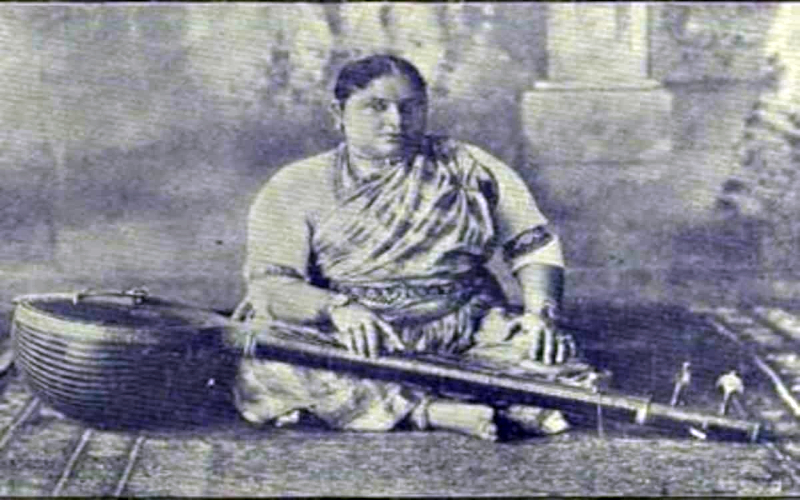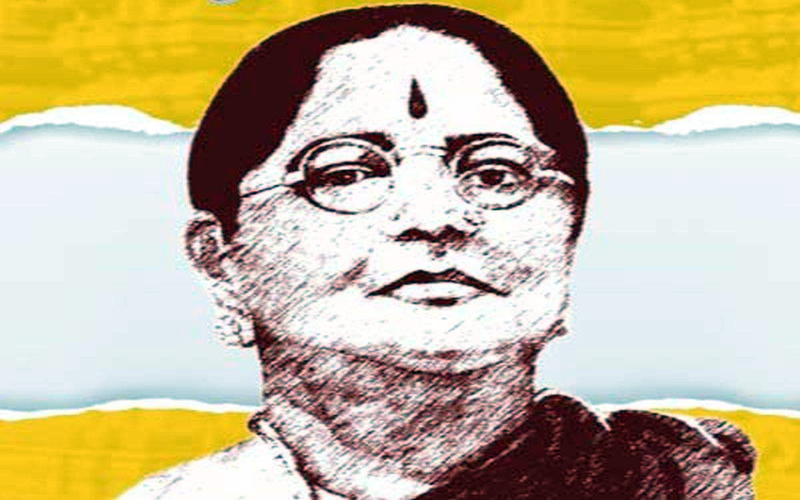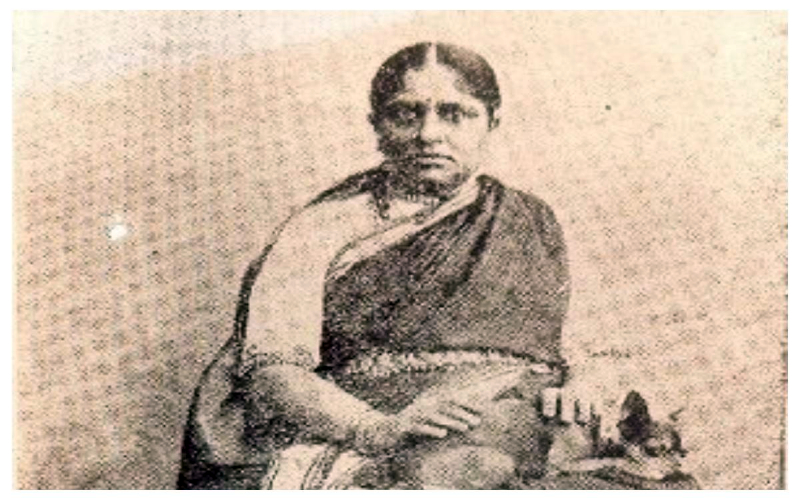
The Devadasi who was devoted to Saint Tyāgaraja
Saint Tyāgaraja (1767 - 1847) was a great composer. His compositions on Lord Rama are world famous. Every Carnatic music concert has always contained a composition of Tyāgaraja, who was affectionately known as Tyāgayya. His ‘Pancaratna Kṛtī-s’ are among his best and a singer proficient in all the five is considered to be a complete singer. Tyāgayya composed in Telugu and he had lived in Thiruvaiyaru near Thanjavur. This town is famous for the Panchanadeeswarar or Aiyarappar Temple. Tyāgayya used to sing songs in praise of Lord Rama and do Unjavṛtti every day. The collection thus obtained was his only source that nurtured him and his family. He was greatly devoted to Lord Rama and was blessed to have had a vision of him.
The Telugu speaking Tyāgayya lived in the Tamil speaking part of the country due to several historical reasons. Peninsular India had been wealthy, and its ports yielded a lot of income. The Cholas, Cheras, Pandyas, Pallavas, Chalukyas, Rashtrikutas, Hoysalas and Kakatiyas had made the South a great cultural space. All of this attracted Malik Kafur and others to ravage it between 1311 and 1327. It began under the reign of Alauddin Khilji, the Sultan of Delhi. The entire South was pillaged and there was absolute anarchy for a few decades. Several of the big temples were shut due to tyranny and oppression. Finally, the Kannada and Telugu armies under the Vijayanagara Prince Kumara Kampana and his wife Ganga Devi (the author of ‘Madura Vijayam’) redeemed all of Tamil Nadu. The multilingual Vijayanagar Empire added to the security, wealth, and culture of the region. They did so by only adding and not deleting the finer aspects of the existing vibrant culture. Telugu, Sanskrit, Tamil became the part of the trilingual culture under the Emperors and their Viceroys - The Naicks of Madurai, Thanjavur, Gingee etc., The Polygars or Palayakkarars served as the third tier of the political system.
The South became wealthy once again and several temples were built. Most of the existing temples were enriched. Interestingly our rulers added to the work of the conquered kings and did not disturb the charity done by them. They just kept adding layers. Carnatic Music, dance, textiles, arts, and crafts flourished for a few centuries. This impact continued under the Maratha rulers of Thanjavur and the Wodeyars of Mysore. The rulers of Kerala were fine examples too.
The Devadasi tradition of the past was nurtured by these rulers and the society of the day. Girls born in the family of dancers were dedicated to the deities in temples. They later had patrons and developed themselves while also creating a progeny for themselves. The Devadasis were talented, pretty and were also highly regarded in the society. Their soft skills and talent helped them to manage wealth and also build a network of contacts. Some of them had armed guards too. Sri Venugopalan the author of the book, ‘Swarnamukhi’ talks about the powerful Devadasis who had trained armies in his work.

Bangalore Nagarathinamma (1878 - 1952) was born in this tradition and she was proud to call herself a Devadasi. A Devadasi was known as a courtesan in English. She was born to Puttu Lakshmi Bai and Subba Rao at Nanjangud. Interestingly Nagarathinamma was known as BNR not just because of her initials but also because of her physical appearance. She was short, plump, and fair. There existed a ‘Bengal Nagpur Railway’ which was also known as BNR and it had a big engine. The physical attributes of Nagarathinamma got her the name BNR.
BNR was an aggressive lady and was quick to understand that there was a greater future in music than dance. She had been trained from the age of 5 and was a fast learner. BNR studied Kannada, English, and Telugu. She did learn under Munuswamippa and teachers like Bidaram Krishnappa. Harikatha was her forte too. She was patronized by the rulers of Travancore, Bobbili, Vizianagaram, Venkatagiri and of course, Mysore. She was the Asthana Vidushi. Her first patron was Narahari Rao, a Judge and it was during this time that BNR lived in Mount Joy that was endowed by the Judge for her. It was at Mount Joy in Bangalore that she met several important personages including Diwan Seshadri Iyer of Mysore. Those opportunities helped her to understand the nuances of a changing world and it helped her to endow herself with excellent skills. Around 1902 she moved to Chennai due to the advice and later the demise of her patron Narahari Rao.
Nagarathinamma moved over to Chennai and got herself a nice house. Her name and fame grew, and she lived in style. She was known for wearing expensive Conjeevarams and loads of diamond studded jewellery. Her huge diamond choker, the big ring embedded with an Arecanut-sized diamond and gem-studded bangles were much spoken about. She used to announce her arrival in an interesting manner. Her well embellished assistants would precede her. One would carry a silver kooja with coffee, another would carry hot water while one would be fanning her with a palm leaf hand-fan. She made lasting friendships with the other leading Devadasis of George Town. Veenai Dhanammal, and Coimbatore Thayi were among them. In fact, the Friday concerts of Veenai Dhanammal were a star attraction those days. She would serve special betel leaves along with fragrance spreading inputs. There would be pin drop silence. BNR was her good friend.
BNR did not like the hot summers in Chennai and therefore she used to drape the inner walls of her home with wet cotton sarees and place a huge piece of ice in the centre. Coimbatore Thayi and herself would have a juice in that atmosphere. BNR gave recordings too but was not comfortable with that kind of activity. She supported a lot of religious causes generously. BNR endowed a small street with shops for a temple. She had a nice pooja room and would recite the 1000 names of Lalitha regularly. BNR was the highest tax paying female artist in India. She had done concerts in 146 cities, towns, and villages. The number of concerts were over 1200. It must have been quite a task to communicate, confirm and travel. However, she had done so with aplomb. BNR was known for her spontaneity and wit. However, she told people not to misinterpret and take these jokes in a negative manner. She defended the Devadasi system and was proud to be one. BNR was an innovator too. She designed her own Tambura to suit her extensive travel plans. Her ability to think and act with excellent planning added to her success.

Nagarathinamma had a dog of her own and her picture with the dog became famous. Her lovely parrot was ever lively in her house which was full of visitors. The excellent host in her made the visits of guests memorable.
The great Devadasi wrote and helped in the publication of books. She fought for preserving her tradition. Several representations were made by her at a time when people like Muthulakshmi Reddiar and others were trying to put an end to the Devadasi custom through legislation. Eventually the courtesans were removed from their temple roles. Well people liked BNR and her voice so much that they used to go her house in order to further enjoy her songs. The Arya Vysya Community were among the many to honour her. People thought that getting flowers and Kumkum from her was auspicious. Very soon it became a custom in Chennai.
She was a great devotee of Saint Tyāgaraja and she used to carry a silver framed picture of him along with her. BNR would always sing his songs and around 1920 she came to know that his Samadhi (resting place) was in a bad condition. She went to Thiruvaiyaru and was pained to see the condition. She invested her money, bought the land around the Samadhi, and constructed a nice temple for Saint Tyāgaraja. She sold her properties to get all this done. Income from her concerts were used for this purpose. Eventually she moved over to Thiruvaiyaru after the times of Veenai Dhanammal and began to live there for the rest of her life.
The Tyāgaraja Ārādhanā used to take place those days under two parties who were known as 'Chinna Katchi' and 'Periya Katchi'. Since she, was a lady and that to a Devadasi, was not permitted to participate and therefore she started her own celebrations. Over time the three groups merged due to her vision and accommodation. She had come from a tradition where the girl child was celebrated, and she ensured it. By 1949, the Ārādhanā was structured in order to have a joint rendering of Pancaratna Kṛtī-s. Here was this lady who had spent money on expensive perfumes and jewellery giving away her wealth for her patron Saint Tyāgaraja.
Eventually, this Vidyāsundarī did the Kumba Āratī in the shrine of Tyāgaraja. None could question her for it was her own place now. She used to always be in communion with Tyāgayya in Telugu. BNR had at last discovered her true patron. She would look into every aspect like the Śraddhaṁ, Unjavṛtti and other offerings at the Tyāgayya Temple. All her personal Vigrahā-s were placed in the temple itself. The Devadasi had fully turned inward and outward to her patron Saint Tyāgayya. V. Sriram of Chennai has done extensive research on her and we must salute him for his contribution. His book, ‘The Devadasi and the Saint: The Life and times of Bangalore Nagarathinamma’ by East West is a very worthy read. The Tamil rendition by Padma Narayanan (published by Kalachuvadu) is amazing.
V. Sriram has written about the poor condition of the Samādhi (memorial) and about the change brought in by BNR. This lover of history however laments while visiting the place. Heritage needs to be preserved and his focus is on that aspect. Bangalore Nagarathinamma was a preserver of heritage. Her good work had popularized the culture of having a portrait of the Saint in the houses of millions of people. Today thousands of musicians and dancers are enriching themselves and the society by singing his compositions. BNR and the musicians of her time – Chinna Katchi and Periya Katchi – had wanted that to happen. The push given by Bangalore Nagarathinamma made it a reality. The shrine of Saint Tyāgaraja in Thiruvaiyaru is a contribution which salutes the immortal composition of the great composer.
BNR had assisted in the publication of the work 'Radhika Santhavam' by Muddu Palani in Telugu. This contained titillating content and therefore attracted the attention of several activists. Kandukuri Veerasalingam came in the way. She fought for her right. Finally, the ban was lifted by T. Prakasam. Nagarathinamma used to love milk with embellishments. She would peep into the kitchen to see the processing of her special milk. The milk would have been on the stove for a long time and therefore would have got a bit condensed. At times, she would go off to sleep by then, but she would get up and drink it. Her fortune was worth about Rs. 2 Lakhs in 1920 and she spent quite a bit of it for the temple of her patron Saint Tyāgaraja. She did not ever financially suffer due to her efforts. Her exposure and intellect ensured her financial safety.
NEXT ARTICLE